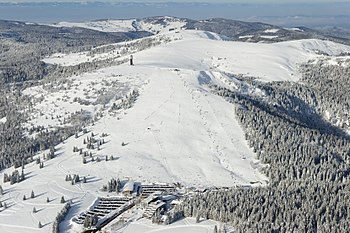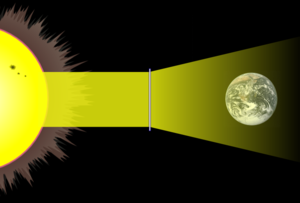
Solar radiation management (SRM) projects are a type of geoengineering which seek to reflect sunlight and thus reduce global warming. They do not reduce greenhouse gas concentrations in the atmosphere, and thus do not address problems such as ocean acidification caused by these gases. Their principle advantage as an approach to geoengineering is the speed with which they can be deployed and become fully active. By comparison, other geoengineering techniques based on greenhouse gas remediation, such as ocean iron fertilization need to sequester the anthropogenic carbon excess before they can arrest global warming. Solar radiation management projects can therefore be used as a geoengineering 'quick fix' while levels of greenhouse gases can be brought under control by greenhouse gas remediation techniques.
A study by Lenton and Vaughan suggest that marine cloud brightening and stratospheric sulfur aerosols are each capable of reversing the warming effect of a doubling of the level of CO2 in the atmosphere when compared to pre-industrial levels.
Background
The phenomenon of global dimming is widely-known, and is not necessarily a geoengineering technique. It occurs in normal conditions, due to aerosols caused by pollution, or caused naturally as a result of volcanoes and major forest fires. However, its deliberate manipulation is a tool of the geoengineer. The majority of recent global dimming has been in the troposphere, except that resulting from volcanos, which affect mainly the stratosphere.
By intentionally changing the Earth's albedo, or reflectivity, scientists propose that we could reflect more heat back out into space, or intercept sunlight before it reaches the Earth through a literal shade built in space. A 0.5% albedo increase would roughly halve the effect of CO2 doubling.
The idea goes back at least to Hoyle (1957) and was expanded on by Kahle and Deirmendjian (1973) of Rand Corporation.
As early as 1974, Russian expert Mikhail Budyko suggested that if global warming became a problem, we could cool down the planet by burning sulfur in the stratosphere, which would create a haze. Paul Crutzen suggests that this would cost 25 to 50 billion dollars per year. It would, however, increase the environmental problem of acid rain. However, this is now believed to be a minor side effect.
These geoengineering projects have been proposed in order to reduce global warming. The effect of rising greenhouse gas concentrations in the atmosphere on global climate is to create a warming effect on the planet. By modifying the albedo (whiteness) of the Earth's surface, or by preventing sunlight reaching the Earth by using a solar shade, this warming effect can be cancelled out - although it should be noted that the cancellation is imperfect, with time of day and regional discrepancies remaining.
The applicability of many techniques listed here has not been comprehensively tested. Even if the effects of small-scale interventions are known, there may be cumulative problems such as ozone depletion, which only become apparent from large scale experiments.
Various small-scale experiments have been carried out on techniques such as cloud seeding, increasing the volume of stratospheric sulfur aerosols and implementing cool roof technology.
A preliminary study by Edward Teller and others in 2002 presented the pros and cons of various relatively "low-tech" proposals to mitigate global warming through scattering/reflecting sunlight away from the Earth via insertion of various materials in the upper stratosphere, low earth orbit, and L1 locations.
Limitations
As well as the imperfect cancellation of the effect of greenhouse gases on global warming, there are other significant problems with solar radiation management as a from of geoengineering not least of these are effects on the global hydrological cycle and the inability of such techniques to reduce ocean acidification. A comprehensive list of problems with geoengineering is available here
However, it should be noted that this type of geoengineering can have indirect benefits, such as keeping permafrost frozen and thus keeping methane locked up within it.
Atmospheric projects
These projects seek to modify the atmosphere, either by enhancing natural processes such as the sulfur cycle, or by using artificial techniques such as reflective balloons.
Stratospheric sulfur aerosols
Stratospheric sulfur aerosols: proposed by Paul Crutzen, with the purpose to modify the Earth's albedo with reflective or absorptive materials spread over portions of its surface. This would typically be achieved using hydrogen sulfide or sulfur dioxide, delivered using artillery, aircraft (such as the high-flying F15-C) or balloons. Ozone depletion is a risk of such techniques, but only if high enough quantities of aerosols drift to, or are deposited in, polar stratospheric clouds before the levels of CFCs and other ozone destroying gases fall naturally to safe levels. This proposal, not unlike the others, carries with it considerable risks, including increased drought or acid rain. Broadly speaking, this technique is seen as a credible geoengineering scheme, although not one without major risks, and challenges for its implementation. This technique can give >3.7W/m2 of globally-averaged negative forcing, which is sufficient to entirely offset the warming caused by a doubling of CO2.
Reflective aerosols or dust
Methods based on increasing the aerosol content in the lower stratosphere for climate modification were proposed by a Russian scientist, Budyko.
United States Patent 5003186 suggested that tiny metal flakes could be "added to the fuel of jet airliners, so that the particles would be emitted from the jet engine exhaust while the airliner was at its cruising altitude." Alternative proposals, not known to have been published in peer-reviewed journals, include the addition of silicon compounds to jet fuel to make silicon dioxide particles in the exhaust.
Alleged secret experiments with aircraft exhaust modification are referred to as the 'Chemtrail Mystery'. or Chemtrail conspiracy theory.
In 1992, a report by the US National Academy of Sciences (NAS) on geoengineering noted that dust is a better choice compared to sulphur, because dust is from natural soil and so should have no noticeable effect on the ground as it gradually falls into the troposphere and rains out. It estimated that about 1010 kg dust would be required to mitigate the warming from a doubling of atmospheric CO2 or about 1 kg dust per 100 t of carbon emissions.
An example of the effects of the imposition of aerosol particles in the atmosphere can be found in history. Comets have been blamed for the dramatic but brief cooling period which commenced in 1159 BCE, and resulted in widespread disruption to civilisations at the time. However, this mechanism, and even the involvement of a comet, is not universally accepted. If a comet was indeed to blame, the action of its aerosols could also have been by the mechanism of cloud condensation nuclei. Other examples of climate change events linked to comets include the famines around 536 CE.
Cloud whitening / marine cloud brightening / cloud reflectivity enhancement

Various schemes have been suggested, such as that proposed by John Latham and Stephen Salter, which works by spraying seawater in the atmosphere to increase the reflectiveness of clouds. The extra condensation nuclei created by the spray will change the size distribution of the drops in existing clouds to make them whiter. The sprayers would use fleets of unmanned Rotor ships known as Flettner vessels to spray mist created from seawater into the air to thicken clouds and thus reflect more radiation from the Earth. The whitening effect is created by using very small cloud condensation nuclei, which whiten the clouds due to the Twomey effect.
This technique can give >3.7W/m2 of globally-averaged negative forcing, which is sufficient to reverse the warming effect of a doubling of CO2.
Ocean sulfur cycle enhancement
Enhancing the natural sulfur cycle in the Southern Ocean ocean by fertilizing a small portion with iron in order to enhance dimethyl sulfide production and cloud reflectivity. The goal is to slow Antarctic ice from melting and raising sea level. Such techniques also tend to sequester carbon, but in this specific project the enhancement of cloud albedo was both the desired outcome and measured result. An alternative technique proposes the vertical mixing of ocean water, to bring deep-water nutrients to surface plankton. This technique can give only 0.016W/m2 of globally-averaged negative forcing, which is essentially insignificant for geoengineering purposes.
Reflective balloons
Place billions of aluminized, hydrogen-filled balloons in the stratosphere has been suggested to provide a reflective screen.
These reflectors would be placed at a high enough altitude so that they do not interfere with air traffic. The cost estimate is about 20 times as much as the distribution of dust in the stratosphere, making these schemes economically nonviable. The large number of reflectors and the trash problem posed by their fall make the system unattractive.
Low stratospheric soot
Decreasing the efficiency of burning in engines of aircraft flying in the low stratosphere would maintain a thin cloud of soot to intercept sunlight. However, the relationship between soot or other combustion products and climate change is complex, with some types causing a warming effect. Almost all aircraft cannot reach the stratosphere in most parts of the world.
Cloud seeding
Cloud stimulation can be carried out using a variety of methods, such as burning sulfur in ships or power plants to form sulfate aerosol in order to stimulate additional low marine clouds to reflect sunlight. Liquid nitrogen can also be used, as can silver iodide "Earlier, Reck (1978) studied the effect of increases in cloud cover and, using a radiative-convective atmospheric model, found that a 4 to 5 percent increase in low-level cloud cover would be sufficient to offset the warming predicted from a doubling of preindustrial CO2. This value is in reasonable agreement with Randall et al. (1984), who estimated that a 4 percent increase was required in the amount of marine stratocumulus, which comprises the bulk of the low clouds on a global basis."
Terrestrial albedo modification
Cool roof

Painting pavements and roof materials in white or pale colours to reflect solar radiation, known as 'cool roof' technology, and encouraged by legislation in some areas (notably California).This is a benign technique, although limited in its ultimate effectiveness by the costrained surface area available for treatment. This technique can give between 0.01-0.19W/m2 of globally-averaged negative forcing, depending on whether cities or all settlements are so treated.This is generally insignificant when compared to the 3.7W/m2 of positive forcing from a doubling of CO2. However, in many cases it can be achieved at little or no cost by simply selecting different materials. Further, it can reduce the need for air conditioning, which causes CO2 emissions which worsen global warming. For this reason alone it is still demonstrably worth pursuing.
Reflective sheeting
Reflective plastic sheets covering 67,000 square miles of desert, to reflect the Sun’s energy. This technique can give globally-averaged 1.74W/m2 of negative forcing, which is insufficient to offset the 3.7W/m2 of positive forcing from a doubling of CO2, but is still a very significant contribution and is sufficient to offset the current level of warming (approx. 1.7W/m2). However, the effect would be strongly regional, and would not be ideal for controlling Arctic shrinkage, which is one of the most significant problems resulting from global warming.
Ocean litter
An early geoengineering idea was to use pale coloured floating litter within certain stable oceanic gyres. This litter would tend to group into large and stable areas, such as the Great Pacific Garbage Patch.
Farming, forestry, and land management
Forestry
Reforestation in tropical areas has a cooling effect. Deforestation of high-latitude and high-altitude forests exposes snow and this increases albedo.
Grassland management
Changes to grassland have been proposed to increase albedo. This technique can give 0.64W/m2 of globally-averaged negative forcing, which is insufficient to offset the 3.7W/m2 of positive forcing from a doubling of CO2, but could make a minor contribution towards it.
High-albedo crop varieties
Selecting or genetically-modifying commercial crops with high albedo has been suggested.This has the advantage of being relatively simple to implement, with farmers simply switching from one variety to another. Temperate areas may experience a 1°C cooling as a result of this technique. This technique is an example of bio-geoengineering. This technique can give 0.44W/m2 of globally-averaged negative forcing, which is insufficient to offset the 3.7W/m2 of positive forcing from a doubling of CO2, but could make a minor contribution towards it.
Space projects
Space-based geoengineering projects are seen by many commentators and scientists as being far-fetched at present.
Space mirrors
Mirrors in space: proposed by Roger Angel with the purpose to deflect a percentage of solar sunlight into space, using mirrors orbiting around the Earth.
Moon dust
Mining moon dust to create a shielding cloud was proposed by Curtis Struck at Iowa State University in Ames
Dispersive solutions

Several authors have proposed dispersing light before it reaches the Earth by putting a very large diffraction grating or lens in space, perhaps at the L1 point between the Earth and the Sun. This plan was proposed in 1989 by J. T. Early, and in 1997 by Edward Teller, Lowell Wood, and Roderick Hyde. In 2004, physicist and science fiction author Gregory Benford calculated that a concave rotating Fresnel lens 1000 kilometres across, yet only a few millimeters thick, floating in space at the L1 point, would reduce the solar energy reaching the Earth by approximately 0.5% to 1%. He estimated that this would cost around US$10 billion up front, and another $10 billion in supportive cost during its lifespan. Side-effects include that, if this lens were built and global warming were avoided, there would be less incentive to reduce greenhouse gases, and humans might continue to produce too much carbon dioxide until it caused some other environmental catastrophe, such as a chemical change in ocean water that could be disastrous to ocean life.
Putting a very large diffraction grating (thin wire mesh) or lens in space, perhaps at the L1 point between the Earth and the Sun.
From http://en.wikipedia.org/
No comments:
Post a Comment